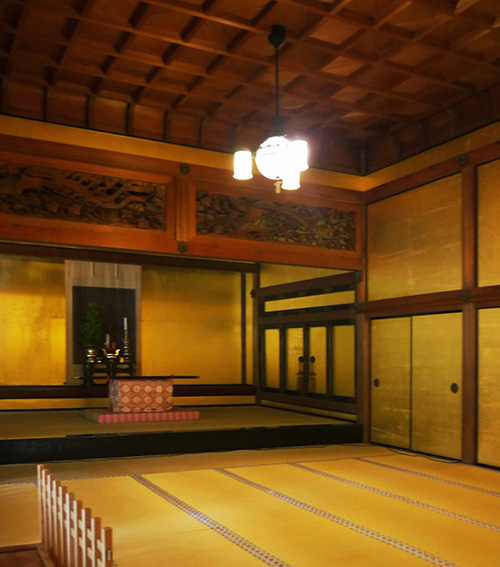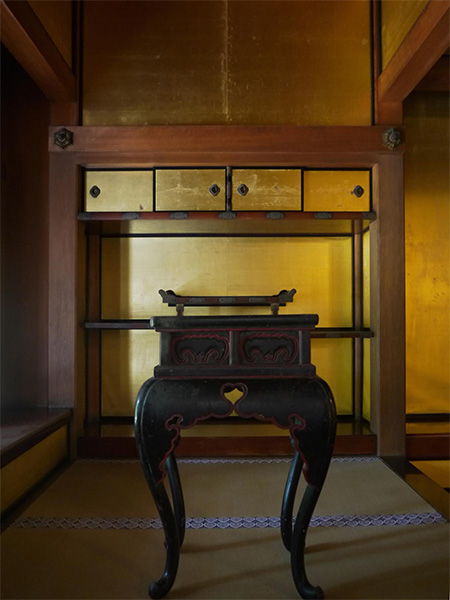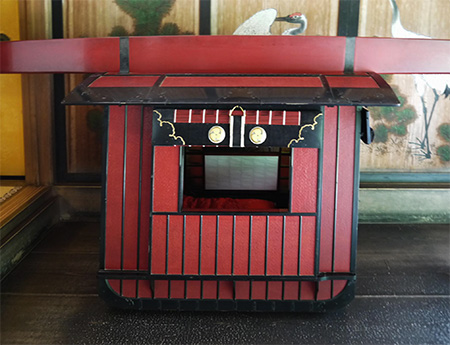


わが家の宗旨は真言宗なので、上の空海さんの画像は見慣れています。
江戸時代の頃には空前の旅行ブームが庶民に訪れていたとされ、
わが家系でも「四国お遍路」に何人か行っていると聞いています。
で、この画像は大量に複製されていたのでしょう、
88ヵ所参詣の記念として購入し仏壇に飾られ続けていたのです。
年に数回はお目にかかるお坊さんから「高野山でお大師さんに」と
来訪を促されてもいたので、わたしも願いが成就できたと勝手に決定(笑)。
800年代に天台の比叡山・最澄と同時期に入唐して
最新の仏教法典と密教の教えを日本にもたらせた空海さんは、
同輩的な立場の最澄に対して密教の立場からの「灌頂」を施している。
最澄さんの仏教への真摯な側面を表していて感銘を受けるところ。
そういった経緯もあって、日本では空海さんは未曾有の宗教上の巨人。
とくに高野山に於いては、かれの神格化が歴史時間を掛けて深まってきた。
この本山・金剛峯寺の奥殿は空海生前のままに保持されているかのよう。


空海さんが涅槃に旅立たれるのに不自由がないように
身の回りの必需品や乗り物なども用意周到に準備されている。
この「奥殿」の建築造営でもまだ足らずに、奥の院まで建立され
いまでも毎日、まるで空海さんが生けるがごとく
食事の用意を捧げられ続けているのだという。
日本人としてこうまで永く尊崇され続けているひともいないでしょうね。
関西文化圏に属する司馬遼太郎にも「空海の風景」という著述がある。
日本という文化圏のなかで非常に巨大な影響力を持った
仏教にとって最大級の個人業績だったのだろうと思います。
ことがらが宗教のことであり、その後の宗派の他者への攻撃性などもなく
稀有な幸運に彩られていると言えるでしょうね。
多くの日本人が天皇も含めてこの空間に身を置くことで
空海さんと対面できたような思いを抱くことができる。
建築がその空気感で空海さんの息づかいを表現するかのような。
建築の意味がまざまざと伝わってくるような気がしました。
南無大師遍照金剛、南無大師遍照金剛・・・。
English version
[Kukai-san’s private space, Okuden Koyasan, Kongobuji-11]
Since the sect of my family is the Shingon sect, I am familiar with the image of Mr. Kukai above.
It is said that an unprecedented travel boom was coming to the common people around the Edo period.
I heard that some people in my family also go to “Shikoku Pilgrimage”.
So this image was probably duplicated in large numbers,
It seems that it was purchased to commemorate the visit to 88 places and continued to be displayed on the Buddhist altar.
A monk I see several times a year says, “To a master at Mt. Koya.”
I was also prompted to visit, so I decided that my wish was fulfilled (laughs).
Entered Tang in the 800s at the same time as Mt. Hiei and Saicho in Tendai
Kukai, who brought the latest Buddhist code and esoteric teachings to Japan,
Saicho, who is in a peer position, is given “abhisheka” from the standpoint of esoteric Buddhism.
I am impressed by the sincere aspect of Saicho’s Buddhism.
For that reason, Kukai is an unprecedented religious giant in Japan.
Especially on Mt. Koya, his deification deepened over the course of history.
It seems that the inner shrine of Kongobuji Temple, the main mountain, is kept as it was before Kukai-san was alive.
So that Kukai-san will not be inconvenienced when he departs for Nirvana.
The necessities and vehicles around him are well prepared.
This “Okunoin” is still not enough, and even the Okunoin was built.
Even now, every day, it’s like Kukai-san is alive.
He says he continues to be devoted to preparing meals.
No one would have been revered as a Japanese for such a long time.
Ryotaro Shiba, who belongs to the Kansai cultural area, also wrote “Kukai no Scenic”.
He had a huge influence in the cultural sphere of Japan
I think it was one of the greatest personal achievements for Buddhism.
Things are religions, and there is no subsequent aggression against others of the denomination.
It can be said that it is colored by rare luck.
By putting themselves in this space, including the emperor, many Japanese
It makes me feel like I was able to meet Kukai-san.
I felt that the meaning of architecture was conveyed in various ways.
It’s as if the architecture expresses Kukai’s breathing with that atmosphere.
Nanmu Daishi Henjo Kongo, Nanmu Daishi Henjo Kongo …
Posted on 11月 5th, 2021 by 三木 奎吾
Filed under: 住宅マーケティング, 日本社会・文化研究








コメントを投稿
「※誹謗中傷や、悪意のある書き込み、営利目的などのコメントを防ぐために、投稿された全てのコメントは一時的に保留されますのでご了承ください。」
You must be logged in to post a comment.